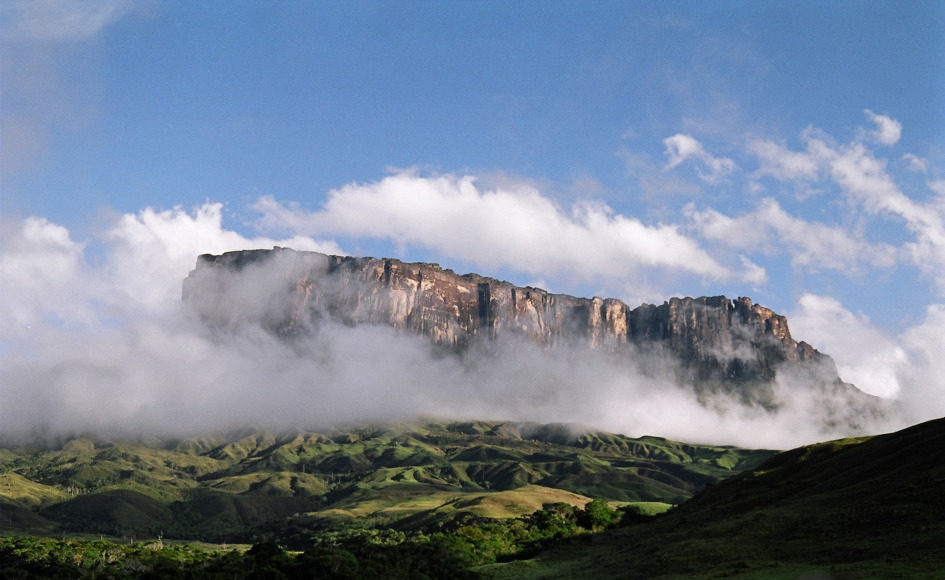A few years ago I lay in a hammock in a mud and wattle hut in a Makuxi village, shining my torch on the walls to look for spiders, listening to the BBC World Service on my radio (I learnt that Labour leader John Smith had died). There was no light – the noisy diesel generator which provided a few hours energy each day was turned off at night.
 The Makuxi, one of Brazil’s largest indigenous communities, with about 19,000 people and 140 villages, inhabit an area of savannah and sierras in the far northern state of Roraima, sharing borders with Venezuela and Guyana.
Their land, which was offically recognised by a Supreme Court ruling only in 2009, after years of conflict with invading goldminers, cattle ranchers and rice farmers, stretches to the foothills of the imposing Mount Roraima, a table top mountain with sheer cliffs rising 9,000 feet (2,750 m) high.
This was the mountain that inspired Arthur Conan Doyle to write The Lost World, published one hundred years ago. In the book, prehistoric creatures still roamed the plateau of a remote table mountain. The Makuxi, however, are more concerned with today’s problems than yesterday’s myths.
After the illegal occupiers had been expelled, they began the task of restoring land and rivers contaminated by years of pesticides. And they are now looking for ways to replace the old diesel-powered generators with renewable sources of energy. The nearest power grid is 185 miles (300 kms) away.
The Makuxi, one of Brazil’s largest indigenous communities, with about 19,000 people and 140 villages, inhabit an area of savannah and sierras in the far northern state of Roraima, sharing borders with Venezuela and Guyana.
Their land, which was offically recognised by a Supreme Court ruling only in 2009, after years of conflict with invading goldminers, cattle ranchers and rice farmers, stretches to the foothills of the imposing Mount Roraima, a table top mountain with sheer cliffs rising 9,000 feet (2,750 m) high.
This was the mountain that inspired Arthur Conan Doyle to write The Lost World, published one hundred years ago. In the book, prehistoric creatures still roamed the plateau of a remote table mountain. The Makuxi, however, are more concerned with today’s problems than yesterday’s myths.
After the illegal occupiers had been expelled, they began the task of restoring land and rivers contaminated by years of pesticides. And they are now looking for ways to replace the old diesel-powered generators with renewable sources of energy. The nearest power grid is 185 miles (300 kms) away.
 region of their reserve, Raposa-Serra do Sol, enjoys some of the strongest winds in the country, with speeds of up to 11 metres per second being registered, and an average of six to nine metres.
So in February three towers were installed to measure the winds over the period of a year, in order to calculate the potential for generating energy. The project is the result of a three-way partnership between the Indigenous Council of Roraima (CIR), the Socioenvironmental Institute (ISA), one of Brazil’s largest NGOs, and the Federal University of Maranhão (UFMA).
The towers were installed by the Makuxi themselves. They also plan to map the energy needs of each family in their communities. A team of 14 indigenous researchers is travelling round the villages with GPS equipment and questionnaires.
They hope the energy to be generated will be enough, not only for domestic consumption, but also for the agricultural activities they are also preparing, as part of their plan to develop their reserve sustainably.
region of their reserve, Raposa-Serra do Sol, enjoys some of the strongest winds in the country, with speeds of up to 11 metres per second being registered, and an average of six to nine metres.
So in February three towers were installed to measure the winds over the period of a year, in order to calculate the potential for generating energy. The project is the result of a three-way partnership between the Indigenous Council of Roraima (CIR), the Socioenvironmental Institute (ISA), one of Brazil’s largest NGOs, and the Federal University of Maranhão (UFMA).
The towers were installed by the Makuxi themselves. They also plan to map the energy needs of each family in their communities. A team of 14 indigenous researchers is travelling round the villages with GPS equipment and questionnaires.
They hope the energy to be generated will be enough, not only for domestic consumption, but also for the agricultural activities they are also preparing, as part of their plan to develop their reserve sustainably.
 The Makuxi, one of Brazil’s largest indigenous communities, with about 19,000 people and 140 villages, inhabit an area of savannah and sierras in the far northern state of Roraima, sharing borders with Venezuela and Guyana.
Their land, which was offically recognised by a Supreme Court ruling only in 2009, after years of conflict with invading goldminers, cattle ranchers and rice farmers, stretches to the foothills of the imposing Mount Roraima, a table top mountain with sheer cliffs rising 9,000 feet (2,750 m) high.
This was the mountain that inspired Arthur Conan Doyle to write The Lost World, published one hundred years ago. In the book, prehistoric creatures still roamed the plateau of a remote table mountain. The Makuxi, however, are more concerned with today’s problems than yesterday’s myths.
After the illegal occupiers had been expelled, they began the task of restoring land and rivers contaminated by years of pesticides. And they are now looking for ways to replace the old diesel-powered generators with renewable sources of energy. The nearest power grid is 185 miles (300 kms) away.
The Makuxi, one of Brazil’s largest indigenous communities, with about 19,000 people and 140 villages, inhabit an area of savannah and sierras in the far northern state of Roraima, sharing borders with Venezuela and Guyana.
Their land, which was offically recognised by a Supreme Court ruling only in 2009, after years of conflict with invading goldminers, cattle ranchers and rice farmers, stretches to the foothills of the imposing Mount Roraima, a table top mountain with sheer cliffs rising 9,000 feet (2,750 m) high.
This was the mountain that inspired Arthur Conan Doyle to write The Lost World, published one hundred years ago. In the book, prehistoric creatures still roamed the plateau of a remote table mountain. The Makuxi, however, are more concerned with today’s problems than yesterday’s myths.
After the illegal occupiers had been expelled, they began the task of restoring land and rivers contaminated by years of pesticides. And they are now looking for ways to replace the old diesel-powered generators with renewable sources of energy. The nearest power grid is 185 miles (300 kms) away.
Planning for sustainability
The Brazilian Government has a programme to bring electricity to rural communities which is called Light For All, and it is considering building a number of dams inside the Makuxi reserve. But the Makuxi have come up with another idea. The Brazilian Atlas of Wind Potential shows that the northern region of their reserve, Raposa-Serra do Sol, enjoys some of the strongest winds in the country, with speeds of up to 11 metres per second being registered, and an average of six to nine metres.
So in February three towers were installed to measure the winds over the period of a year, in order to calculate the potential for generating energy. The project is the result of a three-way partnership between the Indigenous Council of Roraima (CIR), the Socioenvironmental Institute (ISA), one of Brazil’s largest NGOs, and the Federal University of Maranhão (UFMA).
The towers were installed by the Makuxi themselves. They also plan to map the energy needs of each family in their communities. A team of 14 indigenous researchers is travelling round the villages with GPS equipment and questionnaires.
They hope the energy to be generated will be enough, not only for domestic consumption, but also for the agricultural activities they are also preparing, as part of their plan to develop their reserve sustainably.
region of their reserve, Raposa-Serra do Sol, enjoys some of the strongest winds in the country, with speeds of up to 11 metres per second being registered, and an average of six to nine metres.
So in February three towers were installed to measure the winds over the period of a year, in order to calculate the potential for generating energy. The project is the result of a three-way partnership between the Indigenous Council of Roraima (CIR), the Socioenvironmental Institute (ISA), one of Brazil’s largest NGOs, and the Federal University of Maranhão (UFMA).
The towers were installed by the Makuxi themselves. They also plan to map the energy needs of each family in their communities. A team of 14 indigenous researchers is travelling round the villages with GPS equipment and questionnaires.
They hope the energy to be generated will be enough, not only for domestic consumption, but also for the agricultural activities they are also preparing, as part of their plan to develop their reserve sustainably.

